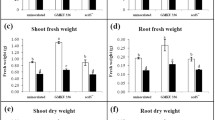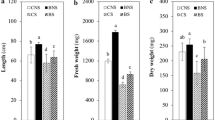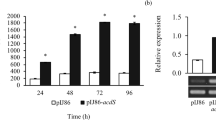Abstract
The endophytic fungus Phomopsis liquidambaris is characterized as a plant growth-promoting agent under salt stress, but its mechanism is unknown. Herein, 1-aminocyclopropane-1-carboxylate deaminase (ACCD) from the strain was confirmed that it had the ability of utilizing 1-aminocyclopropane-1-carboxylate as the sole nitrogen source. The full-length ACCD gene was 1152 bp, which encodes a mature protein of 384 amino acids with a molecular mass of 41.53 kDa. The ACCD activity was 3.9-fold in 3 mmol L−1 ACC by qRT-PCR under salt stress comparing with no salt tress. Ethylene production was increased to 34.55–70.60% and reduced the growth of rice by 23–69.73% under salt stress. Inoculation of P. liquidambaris increased root-shoot length, fresh and dry weight, and overall growth of stressed rice seedlings. ACC accumulation, ACC synthase and ACC oxidase activities increased in salt-treated rice seedlings, while they were significantly reduced when P. liquidambaris was inoculated into rice by qRT-PCR. It therefore can be concluded that P. liquidambaris can be used as a plant growth promoting fungus against salt stress and other biotic or abiotic stresses.




Similar content being viewed by others
Change history
14 March 2022
A Correction to this paper has been published: https://doi.org/10.1007/s00203-022-02821-0
Abbreviations
- ACC:
-
1-Aminocyclopropane-1-carboxylic acid
- ACCD:
-
ACC deaminase
- ACS:
-
ACC synthase
- ACO:
-
ACC oxidase
- SAM:
-
S-adenosyl methionine
- AVG:
-
Aminoethoxyvinylglycine
- PGPM:
-
Plant growth promoting microorganisms
References
Abeles FB, Morgan PW, Saltveit ME (1992) Ethylene in plant biology. Academic Press, San Diego, pp 113–114
Arshad M, Frankenberger WT (2002) Ethylene: agricultural sources and application. Kluwer Academic/Plenum Publisher, NY, USA
Ashraf M, Ali Q (2008) Relative membrane permeability and activities of some antioxidant enzymes as the key determinants of salt tolerance in canola (Brassica napus L.). Environ Exp Bot 63:266–273
Barnawal D, Bharti N, Maji D, Chanotiya CS, Kalra A (2014) ACC deaminase-containing Arthrobacter protophormiae induces NaCl stress tolerance through reduced ACC oxidase activity and ethylene production resulting in improved nodulation and mycorrhization in Pisum sativum. J Plant Physiol 171:884–894
Bayliss C, Bent E, Culham DE, MacLellan S, Clarke AJ, Brown GL, Wood JM (1997) Bacterial genetic loci implicated in the Pseudomonas putida GR12-2R3-canola mutualism: identification of an exudate-inducible sugar transporter. Can J Microbiol 43:809–818
Burd GI, Dixon DG, Glick BR (2000) Plant growth-promoting bacteria that decrease heavy metal toxicity in plants. Can J Microbiol 46:237–245
Chen Y, Peng Y, Dai CC, Ju Q (2011) Biodegradation of 4-hydroxybenzoic acid by Phomopsis liquidambari. Appl Soil Ecol 51:102–110
Chen Y, Wang HW, Li L, Dai CC (2013a) The potential application of the endophyte Phomopsis liquidambaris to the ecological remediation of long-term cropping soil. Appl Soil Ecol 67:20–26
Chen Y, Xie XG, Ren CG, Dai CC (2013b) Degradation of N-heterocyclic indole by a novel endophytic fungus Phomopsis liquidambari. Bioresour Technol 129:568–574
Cheng Z, Park E, Glick BR (2007) 1-Aminocyclopropane-1-carboxylate deaminase from Pseudomonas putida UW4 facilitates the growth of canola in the presence of salt. Can J Microbiol 53:912–918
Duan J, Muller KM, Charles TC, Vesely S, Glick BR (2009) 1-Aminocyclopropane-1-carboxylate (ACC) deaminase genes in rhizobia from southern Saskatchewan. Microb Ecol 57:423–436
Feng Y, Shen D, Song W (2006) Rice endophyte Pantoea agglomerans YS19 promotes host plant growth and affects allocations of host photosynthates. J Appl Microbiol 100:938–945
Glick BR (2005) Modulation of plant ethylene levels by the bacterial enzyme ACC deaminase. FEMS Microbiol Lett 251:1–7
Glick BR, Patten CL, Holguin G, Penrose DM (1999) Biochemical and genetic mechanisms used by plant growth promoting bacteria. Imperial College Press, London, p 270
Glick BR, Cheng Z, Czarny J, Duan J (2007) Promotion of plant growth by ACC deaminase-producing soil bacteria. Eur J Plant Pathol 119:329–339
Grichko VP, Glick BR (2001) Amelioration of flooding stress by ACC deaminase-containing plant growth-promoting bacteria. Plant Physiol Biochem 39:11–17
Indiragandhi P, Anandham R, Kim KA, Yim WJ, Madhaiyan M, Sa TM (2008) Induction of defense responses in tomato against Pseudomonas syringae pv. tomato by regulating the stress ethylene level with Methylobacterium oryzae CBMB20 containing 1-aminocyclopropane-1-carboxylate deaminase. World J Microbiol Biotech 24:1037–1045
Jia YJ, Ito H, Matsui H, Honma M (2000) 1-Aminocyclopropane-1-carboxylate (ACC) deaminase induced by ACC synthesized and accumulated in Penicillium citrinum intracellular spaces. Biosci Biotech Bioch 64:299–305
Kohler J, Caravaca F, Carrasco L, Roldan A (2006) Contribution of Pseudomonas mendocina and Glomus intraradices to aggregates stabilization and promotion of biological properties in rhizosphere soil of lettuce plants under field conditions. Soil Use Manage 22:298–304
Lichtenthaler HK et al (1981) Photosynthetic activity, chloroplast ultrastructure, and leaf characteristics of high-light and low-light plants and of sun and shade leaves. Photosynthesis Res 2:115–141
Livak KJ, Schmittgen TD (2001) Analysis of relative gene expression data using real-time quantitative PCR and the 2(-Delta Delta C(T)) method. Methods 25:402–408
Lowry OH, Rosebrough NJ, Farr AL, Randall RJ (1951) Protein measurement with folin-phenol reagent. J Biol Chem 193:265–275
Madhaiyan M, Poonguzhali S, Sa TM (2007) Characterization of 1-aminocyclopropane-1-carboxylate (ACC) deaminase containing Methylobacterium oryzae and interactions with auxins and ACC regulation of ethylene in canola (Brassica campestris). Planta 226:867–876
Morgan PW, Drew MC (1997) Ethylene and plant responses to stress. Physiol Plant 100:620–630
Mortensen LM (1989) Effect of ethylene on growth of greenhouse lettuce at different light and temperature levels. Sci Hortic 39:97–103
Munns R, Termaat A (1986) Whole-plant responses to salinity. Aust J Plant Physiol 13:143–160
Nascimento FX, Rossi MJ, Soares CRFS, McConkey BJ, Glick BR (2014) New insights into 1-aminocyclopropane-1-carboxylate (ACC) deaminase phylogeny, evolution and ecological significance. Plos One 9(6):e99168. https://doi.org/10.1371/journal.pone.0099168
Park KY, Drory A, Woodson WR (1992) Molecular cloning of an 1-minocyclopropane-1-carboxylate synthase from senescing carnation flower petals. Plant Mol Biol 18:377–386
Sergeeva E, Shah S, Glick BR (2006) Growth of transgenic canola (Brassica napus) expressing a bacterial 1-aminocyclopropane-1-carboxylate (ACC) deaminase gene on high concentrations of salt. World J Microbiol Biotechnol 22:277–282
Shi Y, Dai CC, Wu YC, Yuan ZL (2004) Study on the degradation of wheat straw by endophytic fungi. Acta Sci Circum 24:144–149
Siddikee MA, Chauhan PS, Anandham R, Han GH, Sa TM (2010) Isolation, characterization, and use for plant growth promotion under salt stress, of ACC deaminase-producing halotolerant bacteria derived from coastal soil. J Microbiol Biotechnol 20(11):1577–1584
Siddikee MA, Glick BR, Chauhan PS, Yim WJ, Sa TM (2011a) Enhancement of growth and salt tolerance of red pepper seedlings (Capsicum annuum L.) by regulating stress ethylene synthesis with halotolerant bacteria containing 1-aminocyclopropane-1-carboxylic acid deaminase activity. Plant Physiol Biochem 49:427–434
Siddikee MA, Chauhan PS, Sa TM (2011) Regulation of ethylene biosynthesis under salt stress in red pepper (Capsicum annuum L.) by 1-aminocyclopropane-1-carboxylic acid (ACC) deaminase-producing halotolerant bacteria. J Plant Growth Regul. https://doi.org/10.1007/s00344-011-9236-6
Tao JJ, Chen HW, Ma B, Zhang WK, Chen SY, Zhang JS (2015) The role of ethylene in plants under salinity stress. Front Plant Sci 6:1059
Thompson JD, Higgins DG, Gibson TJ (1994) CLUSTAL W: improving the sensitivity of progressive multiple sequence alignment through sequence weighting, position specific gap penalties and weight matrix choice. Nucleic Acids Res 22:4673–4680
Tian LS, Dai CC, Zhao YT, Zhao M, Yong YH, Wang XX (2007) The degradation of phenanthrene by endophytic fungi Phomopsis sp. single and co-cultured with rice. China Environ Sci 27:757–762
Timmusk S, Gerhart E, Wagner H (1999) The plant-growth-promoting rhizobacterium Paenibacillus polymyxa induces changes in Arabidopsis thaliana gene expression: a possible connection between biotic and abiotic stress responses. MPMI 12(11):951–959
Todorovic B, Glick BR (2008) The interconversion of ACC deaminase and D-cysteine desulfhydrase by directed mutagenesis. Planta 229(1):193–205
Viterbo A, Landau U, Kim S, Chernin L, Chet I (2010) Characterization of ACC deaminase from the biocontrol and plant growth-promoting agent Trichoderma asperellum T203. FEMS Microbiol Lett 305(1):42–48
Wachter R, Fischer K, Gabler R, Kuhnemann F, Urban W, Bogemann GM, Voesenek LACJ, Blom CWPM, Ullrich CI (1999) Ethylene production and ACC accumulation Agrobacterium tumefaciens induced plant tumours and their impact on tumour and host stem structure and function. Plant Cell Environ 22:1263–1273
Wang KLC, Li H, Ecker JR (2002) Ethylene biosynthesis and signaling networks. Plant Cell 14:131–151
Wang HW, Zhang W, Su CL, Zhu H, Dai CC (2015) Biodegradation of the phytoestrogen luteolin by the endophytic fungus Phomopsis liquidambari. Biodegradation. https://doi.org/10.1007/s10532-015-9727-4
Yang B, Wang XM, Ma HY, Yang T, Jia Y, Zhou J, Dai CC (2015) Fungal endophyte Phomopsis liquidambaris affects nitrogen transformation processes and related microorganisms in the rice rhizosphere. Front Microbiol 6:982
Yi HC, Joo S, Nam KH, Lee JS, Kang BG, Kim WT (1999) Auxin and brassinosteroid differentially regulate the expression of three members of the 1-aminocyclopropane-1-carboxylate synthase gene family in mung bean (Vigna radiata L.). Plant Mol Biol 41:443–454
Yim WJ, Kim KY, Lee YW, Sundaram SP, Lee Y, Sa TM (2014) Real time expression of ACC oxidase and PR-protein genes mediated by Methylobacterium spp. in tomato plants challenged with Xanthomonas campestris pv. Vesicatoria. J Plant Physiol 171:1064–1075
Yuan ZL, Dai CC, Li X, Tian LS, Wang XX (2007) Extensive host range of an endophytic fungus affects the growth and physiological functions in rice (Oryza sativa L.). Symbiosis 43:21–28
Yuan ZL, Zhang CL, Lin FC (2010) Role of diverse non-systemic fungal endophytes in plant performance and response to stress: progress and approaches. J Plant Growth Regul 29:116–126
Yuan J, Sun K, Deng-Wang M-Y, Dai C-C (2016) The mechanism of ethylene signaling induced by endophytic fungus Gilmaniella sp. AL12 mediating sesquiterpenoids biosynthesis in Atractylodes lancea. Front Plant Sci 7:361
Zahir ZA, Munir A, Asghar HN, Shaharoona B, Arshad M (2007) Effectiveness of rhizobacteria containing ACC-deaminase for growth promotion of pea (Pisum sativum) under drought conditions. J Microbiol Biotechnol 18:958–963
Zahir AZ, Ghani U, Naveed M, Nadeem SM, Asghar HN (2009) Comparative effectiveness of Pseudomonas and Serratia sp. containing ACC-deaminase for improving growth and yield of wheat (Triticum aestivum L.) under salt-stressed conditions. Arch Microbiol 191:415-424
Zapata PJ, Botella MA, Pretel MT, Serrano M (2007) Responses of ethylene biosynthesis to saline stress in seedlings of eight plant species. Plant Growth Regul 53:97–106
Zhang W, Lu LY, Hu LY, Cao W, Sun K, Sun QB, Siddikee A, Shi RH, Dai CC (2018) Evidence for the involvement of auxin, ethylene and ROS signaling during primary root inhibition of Arabidopsis by the allelochemical benzoic acid. Plant Cell Physiol 59:1889–1904
Zhou J, Kang L, Wang HW, Yang T, Dai CC (2014) Liquid laccase production by Phomopsis liquidambaris accelerated phenolic acids degradation in long-term cropping soil of peanut. Acta Agricult Scand Sect-B Soil Plant Sci 64:683–693
Acknowledgements
We thank Miss Xiao-Mi Wang from Nanjing Institute of Soil Science, Academy of Science (CAS) for her technical assistance and her help in measuring ethylene produced by salt-stressed rice seedlings using GC. We are grateful to the National Natural Science Foundation of China (31570491), a project funded by the Priority Academic Program Development of Jiangsu Higher Education Institutions, Research Fund of State Key Laboratory of Soil and Sustainable Agriculture, Nanjing Institute of Soil Science, Chinese Academy of Science (Y412201435) for their financial support.
Author information
Authors and Affiliations
Contributions
CCD and MAS designed the experiment. MAS, MIZ, MW and WZ conducted the study, processed the data, performed data analysis, and wrote the paper. All authors discussed the results and commented on the manuscript.
Corresponding author
Ethics declarations
Conflict of interest
The authors declare that they have no known competing financial interests or personal relationships that could have appeared to influence the work reported in this paper.
Ethical statement
Our work complies with the ethical rules applicable for this journal.
Additional information
Communicated by Erko Stackebrandt.
Publisher's Note
Springer Nature remains neutral with regard to jurisdictional claims in published maps and institutional affiliations.
Supplementary Information
Below is the link to the electronic supplementary material.
Rights and permissions
About this article
Cite this article
Siddikee, M.A., Zereen, M.I., Wu, M. et al. Phomopsis liquidambaris reduces ethylene biosynthesis in rice under salt stress via inhibiting the activity of 1-aminocyclopropane-1-carboxylate deaminase. Arch Microbiol 203, 6215–6229 (2021). https://doi.org/10.1007/s00203-021-02588-w
Received:
Revised:
Accepted:
Published:
Issue Date:
DOI: https://doi.org/10.1007/s00203-021-02588-w




